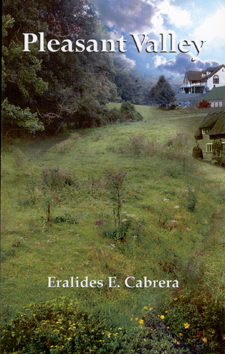|

Pleasant Valley
Eralides E. Cabrera
By Marta Palos
In the pastoral setting of Pleasant Valley, an imaginary town
in the state of New York, we meet Nick Soter, a musical prodigy at seventeen.
He's haunted by ominous visions he attributes to the workings of evil
forces. When his parents die under strange circumstances, his best friend
Mark helps him through the tragic events. Wanting to leave Pleasant
Valley behind, Nick enlists in the army. Wounded in Vietnam, he moves
to California after his recovery and enrolls in college. On the beach
he meets Lori Orman, a free-spirited girl charmed by the musically gifted
Nick. After eight years of happily living together, they decide to marry.
Nick is now a piano-playing physician, Lori a nurse. On their honeymoon
in Acapulco the evil forces show up again and almost drown Nick in the
bay. His wife saves his life. She also persuades him to return together
to his home town, to face his past.
In the second half of the book we enter the realm of science fiction,
unfortunately of the run-of-the-mill kind. In Pleasant Valley an army
of monsters emerge, destructive creatures with the same ghastly attributes
known from science fiction flicks: glowing green eyes, decomposing skin,
a green substance oozing out of their heads when shot in the cerebellum,
the only way to kill them. The creatures hate flowers, plants, and music.
To keep them in check, Nick plays his harmonica, readily found in his
pocket at the most crucial moments. In time he learns that the monsters
consist of pure brain in a human body devoid of internal organs. Their
existence is dependent on a mastermind, and if Nick can destroy the
mastermind, the monsters will turn back to normal people. While he fights
the creatures with the help of the local police, he discovers that the
perpetrator behind all this is none other than his childhood best friend,
Mark.
In the meantime Mark became a psychiatrist, joined the evil forces,
and began to transform the inhabitants of Pleasant Valley into monsters.
After a series of complications, Nick's wife again comes to the rescue
and shoots Mark in the cerebellum. With the green substance oozing out
of his head the mastermind is finished, and the monsters turn back to
normal people. The Soters stay in Pleasant Valley, once more an idyllic
place, and the inhabitants happily start raking the autumn leaves and
painting their picket fences.
Some chapters are too long and too elaborate, diverging from the main
plot. The sinister episode about the cult the Soters run into near Pleasant
Valley is misleading — it turns out that the cult members have
nothing to do with the horrors to follow. There are some unexpected
switches in the point of view, sudden changes in action without transition,
and we find a number of characters of no consequence. The writing style
fluctuates between pedestrian and eloquent, occasionally turning pedantic,
as in "[the]…forehead creases could not hide the raw beauty
that had once permeated herein.").
I'm not sure about the author's intentions. If he wanted to write science
fiction, the foundation to support the story is shaky. The identity
of the evil forces is never revealed, and how exactly the monsters are
created, and above all, why Mark turns against his childhood friend,
remain a mystery. The mastermind's explanation that he created the monsters
because humankind is no longer fit for existence is not convincing.
If the author intended to use the monsters as an allegory for Nick's
traumatic war experiences, the moment he presented the monsters as real,
fought by real people, the allegory did no come through — the story
turned into science fiction.
A fertile imagination is an important tool for a writer, but it is
not the only one. I would advise the author to explore the basic elements
of fiction writing, and to enlist the help of a competent editor before
attempting to publish his next book.
Authorhouse, 2005 (ISBN: 1-4208-2214-4)
|